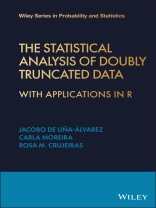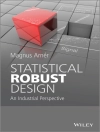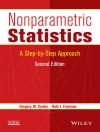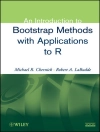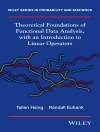A thorough treatment of the statistical methods used to analyze doubly truncated data
In The Statistical Analysis of Doubly Truncated Data, an expert team of statisticians delivers an up-to-date review of existing methods used to deal with randomly truncated data, with a focus on the challenging problem of random double truncation. The authors comprehensively introduce doubly truncated data before moving on to discussions of the latest developments in the field.
The book offers readers examples with R code along with real data from astronomy, engineering, and the biomedical sciences to illustrate and highlight the methods described within. Linear regression models for doubly truncated responses are provided and the influence of the bandwidth in the performance of kernel-type estimators, as well as guidelines for the selection of the smoothing parameter, are explored.
Fully nonparametric and semiparametric estimators are explored and illustrated with real data. R code for reproducing the data examples is also provided. The book also offers:
* A thorough introduction to the existing methods that deal with randomly truncated data
* Comprehensive explorations of linear regression models for doubly truncated responses
* Practical discussions of the influence of bandwidth in the performance of kernel-type estimators and guidelines for the selection of the smoothing parameter
* In-depth examinations of nonparametric and semiparametric estimators
Perfect for statistical professionals with some background in mathematical statistics, biostatisticians, and mathematicians with an interest in survival analysis and epidemiology, The Statistical Analysis of Doubly Truncated Data is also an invaluable addition to the libraries of biomedical scientists and practitioners, as well as postgraduate students studying survival analysis.
Daftar Isi
Preface xi
List of Abbreviations xiii
Notation xv
1 Introduction 1
1.1 Random Truncation 1
1.2 One-sided Truncation 2
1.2.1 Left-truncation 2
1.2.2 Right-truncation 2
1.2.3 Truncation vs. Censoring 3
1.3 Double Truncation 3
1.4 Real Data Examples 5
1.4.1 Childhood Cancer Data 5
1.4.2 AIDS Blood Transfusion Data 6
1.4.3 Equipment-S Rounded Failure Time Data 7
1.4.4 Quasar Data 7
1.4.5 Parkinson’s Disease Data 8
1.4.6 Acute Coronary Syndrome Data 9
References 10
2 One-Sample Problems 13
2.1 Nonparametric Estimation of a Distribution Function 13
2.1.1 The NPMLE 14
2.1.2 Numerical Algorithms for Computing the NPMLE 21
2.1.3 Theoretical Properties of the NPMLE 24
2.1.4 Standard Errors and Confidence Limits 36
2.2 Semiparametric and Parametric Approaches 43
2.2.1 Semiparametric Approach 44
2.2.2 Parametric Approach 52
2.3 R Code for the Examples 56
2.3.1 Code for Example 2.1.8 56
2.3.2 Code for Examples 2.1.11 and 2.1.13 56
2.3.3 Code for Example 2.1.14 58
2.3.4 Code for Example 2.1.15 59
2.3.5 Code for Example 2.1.22 60
2.3.6 Code for Example 2.2.6 61
2.3.7 Code for Example 2.2.8 62
References 65
3 Smoothing Methods 69
3.1 Some Background in Kernel Estimation 69
3.2 Estimating the Density Function 71
3.3 Asymptotic Properties 71
3.4 Data-driven Bandwidth Selection 77
3.4.1 Normal Reference Bandwidth Selection 78
3.4.2 Plug-in Bandwidth Selection 79
3.4.3 Least-squares Cross-validation Bandwidth Selection 80
3.4.4 Smoothed Bootstrap Bandwidth Selection 81
3.4.5 Bandwidth Selectors in Practice 82
3.5 Further Issues in Kernel Density Estimation 88
3.6 Estimating the Hazard Function 90
3.7 R Code for the Examples 98
3.7.1 Code for Example 3.2.1 98
3.7.2 Code for Examples 3.3.4 and 3.3.5 99
3.7.3 Code for Examples 3.4.2 and 3.4.3 100
3.7.4 Code for Example 3.5.1 102
3.7.5 Code for Example 3.6.4 104
3.7.6 Code for Example 3.6.5 105
References 106
4 Regression Analysis 109
4.1 Observational Bias in Regression 109
4.2 Proportional Hazards Regression 114
4.3 Accelerated Failure Time Regression 117
4.4 Nonparametric Regression 121
4.5 R Code for the Examples 126
4.5.1 Code for Example 4.1.1 126
4.5.2 Code for Example 4.1.4 126
4.5.3 Code for Example 4.2.4 127
4.5.4 Code for Example 4.3.2 127
4.5.5 Code for Example 4.4.2 128
References 129
5 Further Topics 131
5.1 Two-Sample Problems 132
5.2 Competing Risks 137
5.2.1 Cumulative Incidences 139
5.2.2 Regression Models for Competing Risks 142
5.3 Testing for Quasi-independence 146
5.4 Dependent Truncation 150
5.5 R Code for the Examples 157
5.5.1 Code for Example 5.1.3 157
5.5.2 Code for Example 5.2.4 159
5.5.3 Code for Example 5.2.6 160
5.5.4 Code for Example 5.3.1 161
5.5.5 Code for Example 5.4.3 161
References 162
A Packages and Functions in R 165
A.1 Computing the NPMLE and Standard Errors 166
A.2 Assessing the Existence and Uniqueness of the NPMLE 167
A.3 Semiparametric and Parametric Estimation 168
A.4 Kernel Estimation 168
A.5 Regression Analysis 169
A.6 Competing Risks 169
A.7 Simulating Data 170
A.8 Testing Quasi-independence 170
A.9 Dependent Truncation 170
References 171
Index 173
Tentang Penulis
Jacobo de Uña-Álvarez is Professor at the Department of Statistics and Operations Research, University of Vigo, Spain.
Carla Moreira is Associate Researcher at the Centre of Mathematics, School of Sciences, University of Minho in Portugal. She is also affiliated to the Statistical Inference, Decision and Operations Research group, University of Vigo, Spain, and to the Epidemiology Research unit, Institute of Public Health, University of Porto, Portugal.
Rosa M. Crujeiras is Associate Professor at the Department of Statistics, Mathematical Analysis and Optimization, University of Santiago de Compostela, Spain.
